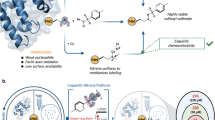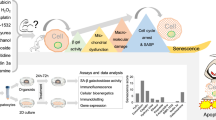Abstract
Purpose
Radiolabeled methionine (Met) promises to be useful in the positron emission tomography (PET) imaging of hepatocellular carcinoma (HCC). However, its metabolic routes in HCC have not yet been fully understood. In this study, the metabolic pathway(s) of radiolabeled Met in HCC were investigated.
Procedures
To simulate the rapid blood clearance of radiolabeled Met, pulse–chase experiments were conducted. l-[methyl-3H]-Met or l-[1-14C]-Met was pulsed over control or cycloheximide-treated WCH17 cells and rat hepatocytes for 5 min and chased with cold media. The water-soluble, lipid-soluble, DNA, RNA, and protein phases were subsequently extracted and measured from the acid-precipitable and acid-soluble fractions of whole cells. The radioactive metabolites Met, S-adenosylmethionine (SAM), S-adenosylhomocysteine, Met sulfoxide, and Met sulfone were further separated by radio thin layer chromatography.
Results
(1) The uptake of l-[methyl-3H]-Met in both cell types was higher than that of l-[1-14C]-Met. In rat hepatocytes, the uptake of l-[methyl-3H]-Met was significantly higher than that of l-[1-14C]-Met, which may contribute to its physiologic accumulation in surrounding hepatic tissues seen in PET imaging of HCC using l-[methyl-11C]-Met. Compared to rat hepatocytes, WCH17 cells had significantly higher uptake of both radiotracers. (2) For l-[methyl-3H]-Met, the major intracellular uptake was found mostly in the protein phase and, to a lesser degree, in the phosphatidylethanolamine (PE) methylation pathway, which is fairly stabilized within the 55-min chase period (the main metabolites were SAM, Met, Met sulfoxide, and Met sulfone). In contrast, the uptake of Met in rat hepatocytes mainly points to phosphatidylcholine (PC) synthesis through the PE methylation pathway (the main metabolite was PC). (3) Both cell types incorporated l-[1-14C]-Met predominantly into protein synthesis. (4) Finally, when the protein synthesis pathway was inhibited, the incorporation of SAM derived from l-[methyl-3H]-Met to lipid class (PC was the main metabolite) occurred at a reduced rate in WCH17 cells, suggesting that the route may be impaired in HCC.
Conclusions
This study demonstrated that different metabolic pathways of radiolabeled Met exist between HCC and surrounding hepatic tissue and contribute to the patterns of increased uptake of radiolabeled Met in HCC.





Similar content being viewed by others
References
Leskinen-Kallio S, Lindholm P, Lapela M et al (1994) Imaging of head and neck tumors with positron emission tomography and [11C]methionine. Int J Radiat Oncol Biol Phys 30:1195–1199
Jager PL, Vaalburg W, Pruim J et al (2001) Radiolabeled amino acids: basic aspects and clinical applications in oncology. J Nucl Med 42:432–445
Leskinen-Kallio S, Ruotsalainen U et al (1991) Uptake of carbon-11-methionine and fluorodeoxyglucose in non-Hodgkin's lymphoma: a PET study. J Nucl Med 32:1211–1218
Nettelbladt OS, Sundin AE, Valind SO et al (1998) Combined fluorine-18-FDG and carbon-11-methionine PET for diagnosis of tumors in lung and mediastinum. J Nucl Med 39:640–647
Inoue T, Kim EE, Wong FC et al (1996) Comparison of fluorine-18-fluorodeoxyglucose and carbon-11-methionine PET in detection of malignant tumors. J Nucl Med 37:1472–1476
Deloar HM, Fujiwara T, Nakamura T et al (1998) Estimation of internal absorbed dose of l-[methyl-11C]methionine using whole-body positron emission tomography. Eur J Nucl Med 25:629–633
Plathow C, Weber WA (2008) Tumor cell metabolism imaging. J Nucl Med 49(Suppl 2):43S–63S
Singhal T, Narayanan TK, Jain V et al (2008) 11C-l-methionine positron emission tomography in the clinical management of cerebral gliomas. Mol Imaging Biol 10:1–18
Bustany P, Chatel M, Derlon JM et al (1986) Brain tumor protein synthesis and histological grades: a study by positron emission tomography (PET) with C11-l-methionine. J Neurooncol 3:397–404
Ishiwata K, Enomoto K, Sasaki T et al (1996) A feasibility study on l-[1-carbon-11]tyrosine and l-[methyl-carbon-11]methionine to assess liver protein synthesis by PET. J Nucl Med 37:279–285
DeLong CJ, Hicks AM, Cui Z (2002) Disruption of choline methyl group donation for phosphatidylethanolamine methylation in hepatocarcinoma cells. J Biol Chem 277:17217–17225
Kuang Y, Salem N, Corn DJ et al (2010) Transport and metabolism of radiolabeled choline in hepatocellular carcinoma. Mol Pharm 7:2077–2092
Maurer U, Charvet C, Wagman AS, Dejardin E, Green DR (2006) Glycogen synthase kinase-3 regulates mitochondrial outer membrane permeabilization and apoptosis by destabilization of MCL-1. Mol cell 21:749–760
Ashwell MA, Work TS (1968) Contrasting effects of cycloheximide on mitochondrial protein synthesis “in vivo” and “in vitro”. Biochem Biophys Res Commun 32:1006–1012
Fu Y, Fang Z, Liang Y et al (2007) Overexpression of integrin beta1 inhibits proliferation of hepatocellular carcinoma cell SMMC-7721 through preventing Skp2-dependent degradation of p27 via PI3K pathway. J Cell Biochem 102:704–718
Bradford MM (1976) A rapid and sensitive method for the quantitation of microgram quantities of protein utilizing the principle of protein-dye binding. Anal Biochem 72:248–254
Ishiwata K, Vaalburg W, Elsinga PH et al (1988) Comparison of l-[1-11C]methionine and l-methyl-[11C]methionine for measuring in vivo protein synthesis rates with PET. J Nucl Med 29:1419–1427
Meyers CL, Meyers DJ (2008) Thin-layer chromatography. Curr Protoc Nucleic Acid Chem Appendix:3D. doi:10.1002/0471142700.nca03ds34
Ishiwata K, Kubota K, Murakami M et al (1993) A comparative study on protein incorporation of l-[methyl-3H]methionine, l-[1-14C]leucine and l-2-[18F]fluorotyrosine in tumor bearing mice. Nucl Med Biol 20:895–899
Vance DE, Houweling M, Lee M, Cui Z (1996) Phosphatidylethanolamine methylation and hepatoma cell growth. Anticancer Res 16:1413–1416
Cui Z, Houweling M, Vance DE (1995) Expression of phosphatidylethanolamine N-methyltransferase-2 in McArdle-RH7777 hepatoma cells inhibits the CDP–choline pathway for phosphatidylcholine biosynthesis via decreased gene expression of CTP:phosphocholine cytidylyltransferase. Biochem J 312(Pt 3):939–945
Capetanaki YG, Flytzanis CN, Alonso A (1982) Repression of the albumin gene in Novikoff hepatoma cells. Mol Cell Biol 2:258–266
Tse TP, Morris HP, Taylor JM (1978) Molecular basis of reduced albumin synthesis in Morris hepatoma 7777. Biochemistry 17:3121–3128
Acknowledgments
We are grateful to Dr. Jim Basilion for sharing the laboratory resources. This work was supported by an NIH/NCI R01 grant CA095307.
Conflict of Interest
The authors declare that they have no conflict of interest.
Author information
Authors and Affiliations
Corresponding author
Additional information
Fangjing Wang and David J. Corn equally contributed to this study.
Electronic Supplementary Material
Below is the link to the electronic supplementary material.
ESM 1
(PDF 511 kb)
Rights and permissions
About this article
Cite this article
Kuang, Y., Wang, F., Corn, D.J. et al. Metabolism of Radiolabeled Methionine in Hepatocellular Carcinoma. Mol Imaging Biol 16, 44–52 (2014). https://doi.org/10.1007/s11307-013-0678-z
Published:
Issue Date:
DOI: https://doi.org/10.1007/s11307-013-0678-z




